
FOOD & NUTRITION
Art, food, fun at Toledo Museum of Art
Museum isn’t just for art fans
7/15/2014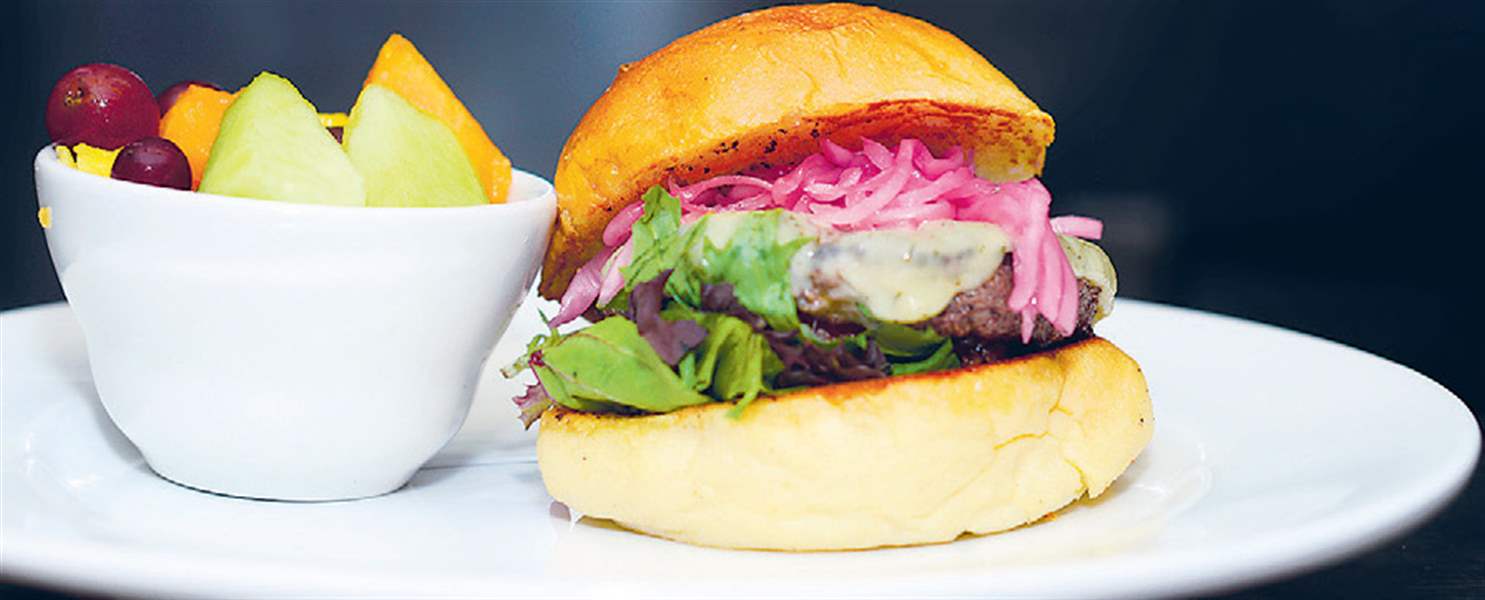
Dill havarti burger with pickled red onions.
THE BLADE
Buy This Image
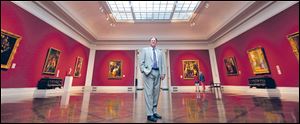
Toledo Museum of Art curator Lawrence Nichols stands in the Great Hall.
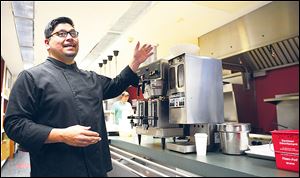
Chef Ruiz explains the features of the museum cafeâs kitchen.
The Toledo Museum of Art is likely not the first place that comes to mind when you think of food. But why not?
There‘s an exceptional cafe, run by executive chef Drew Ruiz, serving an array of delicious dishes to guests each day. The menu selections even feature vegetables and herbs grown in an on-site garden.
There are still life arrangements, freezing moments in time from centuries ago, in which food images serve as everything from historical documentation of dining habits to puns. Lobsters, hams, wine, and game are all found in richly colored oil paintings throughout the museum. And Still Life with Oranges, dated 1818 and found in Gallery 29, shows a bowl of the fruits, one of which is partially peeled as a play on the name of the artist, Raphaelle Peale.
Pieter Claesz’s Still Life With Oysters, dated 1642 and found in Gallery 23, shows a partially-eaten meal complete with torn bread roll and empty shells. A distinctive glass called a roemer is seen on the left side of the painting, and an actual roemer is on display in a case nearby.
Lawrence Nichols, William Hutton Senior Curator and an expert on pre-1900 European and American artworks, says that the pointed nubs on the handle of the roemer are not only beautiful, as they reflect light, but they were also functional. Claesz‘s dinner scene shows a knife, but no fork or other utensils. Food was eaten with hands in the 17th century ... greasy hands. The lack of a smooth base on the roemer, then, according to Dr. Nichols, helped the person holding it to maintain a grip on the glass.

Dill havarti burger with pickled red onions.
The museum also owns modern sculptures depicting food-related scenes. Marisol‘s The Party, in the Wolfe Gallery, features an assortment of life-size guests mingling with some awkwardness as a waiter stoically offers glasses to the disinterested figures. And Emily Brock‘s Counterman-Diner, on display in the Glass Pavilion, portrays a classic counter setting complete with stools, a cash register, a chalkboard menu, and ready-to-slice pies.
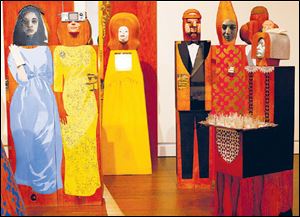
Toledo Museum of Artâs The Party by Marisol Escobar.
There is even a family activity handout sheet to complement the current “The Art of Video Games” exhibit. It’s called “Pac-Man Art Feast,” and it‘s a map for finding “fruit-bearing works of art” throughout the museum. One of the paintings, Frans Hals’ work from the early 1620s, Van Campen Family Portrait in a Landscape, showcases bright red apples strewn from a toppled bucket in contrast to the pervasive black of the family members‘ clothes.
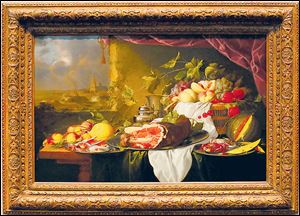
Still Life with a View of the Sea, by Jan Davidsz de Heem.
So, perhaps the next time you go to the museum you might view the artworks from a different perspective, a food-related one, seeking to find the wide variety of examples throughout the galleries and perhaps seeing something new or seeing it in a new way.
Then, once you’ve built up an appetite while admiring so many masterpieces, Mr. Ruiz and his team at the Museum Cafe, just off the lobby at the Grove Street entrance, are waiting to serve you. The menu offers daily specials — among them, a burger of the day — and also creative sandwiches and salads. Wrap options range from Smoked Turkey and Brie, served with Drunken Fruit and Chips, to a Poached Salmon BLT with Green Onion Aioli. For those who are indecisive in the face of temptation, there are “Halvies Mix and Match” options to pair up two smaller servings and not have to commit to only one choice.
Mr. Ruiz says that menu development is “collaborative” with his staff, and that he fosters “very much a strong team environment” in the kitchen. “Everybody holds each other up so well,” he says of his co-workers, from those in the cafe up to Brian Kennedy, President and Director of the museum, whom Mr. Ruiz feels has been one of his most enthusiastic supporters.
He never knows “where inspiration is going to crop up,” but it is important to Mr. Ruiz to be “conscientious of our product.” He seeks to make dishes that are creative and special, and he believes that “great food has an emotional attachment to it.”
But most important, Mr. Ruiz says, “It has to be fun. Food can‘t be all serious.”
So go have some fun with your food this summer, at the Toledo Museum of Art.
Contact Mary Bilyeu at mbilyeu@theblade.com or 419-724-6155 or on Twitter @foodfloozie.
RECIPES
- 1 tablespoon kosher salt
- 1/2 teaspoon dried parsley
- 1/4 teaspoon dried rosemary
- 1/4 teaspoon dried thyme
- 1/4 teaspoon black peppercorns
- Put all ingredients into a coffee/spice grinder until pulverized and uniform.
- 1 whole 2-pound chicken
- 6 grams transglutaminase (available for purchase online), optional
Herb-Rubbed Chicken with Summer Squash and Tomato Chutney, Chickpea Puree, and Cherry and Sriracha Vinaigrette
Place the chicken on a cutting board, breast up, and with a large kitchen knife split the breast bone down the middle. Flip the chicken and pop the thighs out of the sockets to lay it flat in a baking dish. Rob the herb mixture under the skin and roast at 400F for 30-35 minute or until the internal temperature reads 165F.
When finished, reserve all the liquid from the pan; strain and refrigerate. When the meat is cool, pull all the meat from the carcass. Reserve bones for stock, and discard skin to the trash. Adjust seasoning on pulled chicken.
Optional step: Dust cooled and pulled chicken with transglutaminase and place into a plastic wrap-lined baking dish. Press into an even layer across the bottom and place a second dish on top. The transglutaminase will bond the proteins. Apply weight; the chef suggests a gallon of milk. Let set in the refrigerator for 1-4 hours. At this point, the chicken can be cut into any shape from the sheet that has formed.
Summer Squash and Tomato Chutney22 tablespoons rendered bacon fat
- 1/4 cup diced onion
- 1 shaved clove of garlic
- 2-1/2 cups diced yellow squash
- salt and pepper
- 1/2 cup diced tomatoes
- 1 cup baby arugula
In a saute pan over medium-high heat, add bacon fat, onion, and garlic. Heat these items until translucent and fragrant. Add squash and season with salt and pepper. Add tomatoes and cook for several minutes until they release a bit of liquid. Add the arugula, then place everything into a bowl and allow it to wilt. Adjust seasoning.
Chickpea Puree
- 2 cups drained chickpeas
- 1 clove garlic
- zest and juice of 1 lemon
- 1-1/4 tablespoons kosher salt
- several tablespoons reserved cooking liquid from chicken
- 1/4 cup tahini
Place the chickpeas into a food processor. With a microplane, zest the garlic and then the lemon peel over the chickpeas. Add salt and lemon juice, then turn the processor on its highest setting. Use the chicken liquid to flavor and thin the puree to a spreadable consistency. Finally, add the tahini and adjust the seasoning.
Cherry and Sriracha Vinaigrette
- 1/4 cup dried cherries
- 1/4 cup rice wine vinegar
- 1 tablespoon Sriracha hot sauce
- 3/4 cup oil
- salt and pepper
- water, optional
Put cherries, vinegar, and hot sauce into a food processor, then slowly stream in the oil. Adjust seasoning with salt and pepper. If it is too thick, add a tablespoon of water at a time to make it the proper viscosity.
Source: Drew Ruiz, Executive Chef at the Toledo Museum of Art